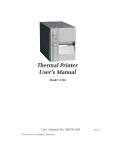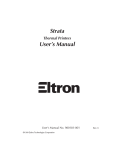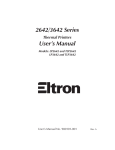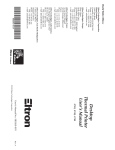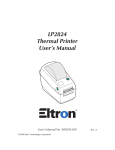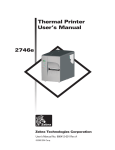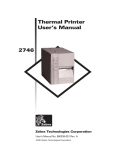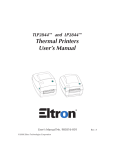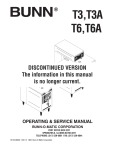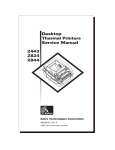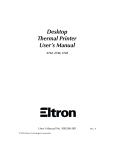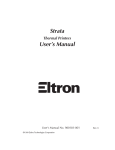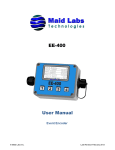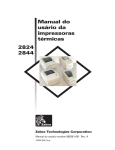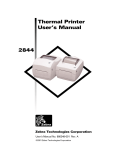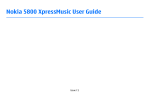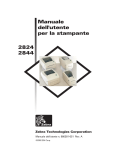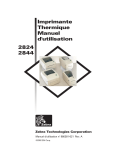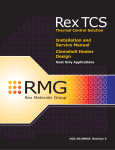Download H Series Thermal Printer User`s Manual
Transcript
H Series Thermal Printer User’s Manual Model Ht-146 User’s Manual No. 980311-001 ©2000 Zebra Technologies Corporation Rev. A COPYRIGHT NOTICE This document contains information proprietary to Zebra Technologies Corporation. This document and the information contained within is copyrighted by Zebra Technologies Corporation and may not be duplicated in full or in part by any person without written approval from Zebra. While every effort has been made to keep the information contained within current and accurate as of the date of publication, no guarantee is given or implied that the document is error-free or that it is accurate with regard to any specification. Zebra reserves the right to make changes, for the purpose of product improvement, at any time. TRADEMARKS Ht-146 is a service mark and Zebra is a trademark of Zebra Technologies Corporation. Windows and MS-DOS are registered trademarks of Microsoft Corp. All other marks are trademarks or registered trademarks of their respective holders. Ht-146 Thermal Printer European Council Directive Compliance to Standards 89/336/EEC EMC Directive EN55022-A, CISPR 22 RF Emissions control 92/31/EE EMC Directive EN50082-1 IEC801 Immunity to Electromagnetic Disturbances 73/23/EEC Low Voltage Directive EN60950 IEC950 Product Safety EMC Directive EN61000-3-2 Harmonic Emissions EMC Directive EN61000-3-3 Voltage Variation FCC - Declaration Of Conformity: Model: Ht-146 conforms to the following specification: FCC Part 15, Subpart B, Section 15.107(a) and Section 15.109(a) Class B digital device Supplemental Information: This device complies with Part 15 of the FCC Rules. Operation is subject to the following Two Conditions: (1) This device may not cause harmful interference , and (2) this device must accept any interference received, including interference that may cause undesired operation. Industry Canada Notice: This device complies with Industry Canada ICS-003 class B requirements. Cet equipement est conforme a l’ICS-003 classe B de la norm Industrielle Canadian ii 980311-001 Rev.A Table of Contents Installation & Operation . . . . . . . . . . . . . . . . . . . . . . . 1 Unpacking Your Printer. . . . . . . . . . . . . . . . . . . . . . . . . . 1 Getting To Know Your Printer . . . . . . . . . . . . . . . . . . . . . . 2 Controls & Indicators . . . . . . . . . . . . . . . . . . . . . . . . . . . 4 Installation . . . . . . . . . . . . . . . . . . . . . . . . . . . . . . . . 6 Media Loading . . . . . . . . . . . . . . . . . . . . . . . . . . . . . . 8 Before You Load Media in the Printer . . . . . . . . . . . . . . . . . . 9 Using AutoSense . . . . . . . . . . . . . . . . . . . . . . . . . . . . 16 Narrow Media Adapters . . . . . . . . . . . . . . . . . . . . . . . . . 19 Thermal Transfer Printer Features . . . . . . . . . . . . . . . . . . . . 20 Loading Transfer Ribbon . . . . . . . . . . . . . . . . . . . . . . . . 20 Configuring Thermal Transfer Printing . . . . . . . . . . . . . . . . . 22 Operator Maintenance . . . . . . Cleaning Your Printer . . . . . Extending Print Head Life . . . Preventing Print Head Failure . Cleaning the Print Head. . . . Platen Cleaning . . . . . . . . Front Bezel Access. . . . . . . . . . . . . . . . . . . . . . . . . . . . . . . . . . . . . . . . . . . . . . . . . . . . . . . . . . . . . . . . . . . . . . . . . . . . . . . . . . . . . . . . . . . . . . . . . . . . . . . . . . . . . . . . . . . . . . . . . . . . . . . . . . . . . . . . . . . . . . . . . . . . . . . 23 23 24 25 26 27 28 Using the Label Dispense Option . Label Dispense Features. . . . . Label Dispenser Mounting. . . . Using Label Dispense . . . . . . Label Dispenser Removal. . . . Peel Bar Removal . . . . . . . . Printing with the Label Dispenser . . . . . . . . . . . . . . . . . . . . . . . . . . . . . . . . . . . . . . . . . . . . . . . . . . . . . . . . . . . . . . . . . . . . . . . . . . . . . . . . . . . . . . . . . . . . . . . . . . . . . . . . . . . . . . . . . . . . . . . . . . . . . . . . . . . . . . . . . 31 31 32 36 40 41 42 Using the Liner Take-Up Option . . . . . . . . Liner Take-Up Features . . . . . . . . . . . . Liner Take-Up with Automatic Label Dispense Manual Label Dispense with Liner Take-up . . . . . . . . . . . . . . . . . . . . . . . . . . . . . . . . . . . . . . . . . . . . . . . . . . . . 43 43 44 48 Using the Media Cutter . . . . . . . . . Media Cutter Features . . . . . . . . . . Cutter Guidelines . . . . . . . . . . . . Specifications . . . . . . . . . . . . . . Cutter Removal . . . . . . . . . . . . . Cleaning and Clearing the Media Cutter. . . . . . . . . . . . . . . . . . . . . . . . . . . . . . . . . . . . . . . . . . . . . . . . . . . . . . . . . . . . . . . . . . . . . . . . . . . . . 49 49 50 50 52 52 . . . . . . . . . . . . . . . . . . Miscellaneous Printer Options . . . . . . . . . . . . . . . . . . . . 55 Factory Installed Printer Options . . . . . . . . . . . . . . . . . . . . 55 Add-On Options. . . . . . . . . . . . . . . . . . . . . . . . . . . . . 55 980311-001 Rev.A iii Liner-free Media Printing . . . . . . . . . . . . Programming with the Real Time Clock Option Asian Language Printers . . . . . . . . . . . . High Resolution 300 dpi Printers . . . . . . . . Keyboard Display Unit (KDU) . . . . . . . . . Eltron PrintServer. . . . . . . . . . . . . . . . . . . . . . . . . . . . . . . . . . . . . . . . . . . . . . . . . . . . . . . . . . . . . . . . . . . . . . . . . . . . . . . . . . . . . . . . . . . . . . Troubleshooting . . . . . . . . . . . . . . . . Where to Start . . . . . . . . . . . . . . . . . . . . Other Support Resources . . . . . . . . . . . . . . . Printer Configuration Settings. . . . . . . . . . . . . Media. . . . . . . . . . . . . . . . . . . . . . . . . Media Sensing . . . . . . . . . . . . . . . . . . . . Reflective Sensor Positioning . . . . . . . . . . . . . Top Of Form Sensing. . . . . . . . . . . . . . . . . Black Mark and Index Hole Sensing Range . . . . . . Print Head Life . . . . . . . . . . . . . . . . . . . . Serial Interface Communication Configuration . . . . RS-232 Serial Interface Cable Wiring . . . . . . . . . Parallel Interface Cable Wiring . . . . . . . . . . . . USB Interface Cable Wiring. . . . . . . . . . . . . . Printer Option: RS-422 Serial Interface Cable Wiring . . . . . . . . . . . . . . . . . . . . . . . . . . . . . . . . . . . . . . . . . . . . . . . . . . . . . . . . . . . . . . . . . . . . . . . . . . . . . . . . . . . . . . . . . . . . . . . . . . . . . . . . . . . . . . . . . . . . . . . . . . . . . . . . . . . . . . . . . . . . . . . . . . . . . . . . . . . . . . . . . . . . . . . 56 57 57 58 58 59 . . . . . . . . . . . . . . . . . . . . . . . . . . . . . . . . . . . . . . . . . . . . . 61 61 64 65 66 66 67 67 68 68 69 69 70 71 71 Supplies and Accessories . . . . . . . . . . . . . . . . . . . . . . 73 Print Head Replacement Procedures . . . . . . . . . . . . . . . . . 75 Identifying Print Head Problems . . . . . . . . . . . . . . . . . . . . . . . . 76 Print Head Replacement . . . . . . . . . . . . . . . . . . . . . . . . . . . . 78 Cover Removal . . . . . . . . . . . . . . . . . . . . . . . . . . . 83 Cover Removal Procedure . . . . . . . . . . . . . . . . . . . . . . . . . . . 83 iv 980311-001 Rev.A General Cautions and Warnings This page describes general safety and maintenance warnings and cautions for the printer and are referenced throughout the manual. Warning - Shock Hazard The printer should never be operated in a location where it can get wet. Personal injury could result. Warning - Static Discharge The discharge of electrostatic energy that accumulates on the surface of the human body or other surfaces can damage or destroy the print head or electronic components used in this device. DO NOT TOUCH the print head or the electronic components under the print head assembly. Caution - Printer Setup & Handling 1)When installing or modifying the printer setup or configuration, ALWAYS TURN POWER OFF Before: A) Connecting any cables. B) Performing any cleaning or maintenance operations. C) Moving the printer. 2) Damage to the printer interface connector, accessories or door may result from placing the printer on it’s front bezel or backside during unpacking or handling. Media Warning Always use high quality approved labels and tags. If adhesive backed labels are used that DO NOT lay flat on the backing liner, the exposed edges may stick to the label guides and rollers inside the printer, causing the label to peel off from the liner and jam the printer. Media Reload Hint If you should run out of labels while printing, DO NOT turn the power switch OFF (0) while reloading or data loss may occur. The printer will automatically resume printing when a new label or ribbon roll is loaded. Print Quality Tip Print density (darkness) is affected by the heat energy (density setting) applied and by the print speed. Changing both Print Speed and Density may be required to achieve the desired results. 980311-001 Rev.A v WARRANTY INFORMATION We Need To Hear From You! To Establish Your Warranty Period And Provide Access To Technical Support, Send Us Your Product Registration Card Today! Zebra Technologies Corporation warrants the mechanism, control electronics and power supply, under normal use and service, to be free from defects in material and workmanship for a period of twelve (12) months from the date of purchase by the end user. Zebra Technologies Corporation warrants the print head, under normal use and service, to be free from defects in material and workmanship for a period of ninety (90) days or 30KM of printing (whichever occurs first) from the date of purchase by the end user. Proof of purchase or product registration is required. If proof of purchase or product registration cannot be established, shipment date to the original buyer (dealer or distributor) will be used to establish the warranty period. Failure to exercise caution to protect the equipment from electrostatic discharge damage, adverse temperature and humidity conditions or physical abuse may void the warranty. Failure to use only Eltron brand approved media may void the warranty. Zebra Technologies Corporation will, at its option, repair or replace the equipment or any parts which are determined to be defective within this warranty period, and which are returned to Zebra Technologies Corporation F.O.B. factory of origin. The warranty set forth above is exclusive and no other warranty, whether written or oral, is expressed or implied. Zebra Technologies Corporation specifically disclaims the implied warranties of merchantability and fitness for a particular purpose. RETURN MATERIALS AUTHORIZATION Before returning any equipment to Zebra for in warranty or out of warranty repair, contact Repair Administration for a Return Materials Authorization (RMA) number. Repack the equipment in the original packing material and mark the RMA number clearly on the outside. Ship the equipment, freight prepaid, to the address listed below: Eltron RMA, USA 1001 Flynn Road Camarillo, CA. 93012 Phone: +1 (805) 579-1800 [email protected] Label Printers: Zebra Technologies, Europe Zebra House The Valley Centre, Gordon Road High Wycombe Buckinghamshire HP13 6EQ, UK Phone: +44 (0) 1494 472872 FAX: +44 (0) 1494 450103 vi Card Printers: Zebra Technologies, Europe Zone Indutrielle, Rue d'Amsterdam 44370 Varades, France Phone: +33 (0) 240 097 070 FAX: +33 (0) 240 834 745 980311-001 Rev.A Installation & Operation 1 Installation & Operation Unpacking Your Open the shipping carton and remove the Printer printer and its accessories. n tio ta en e r um a oc ftw D o r S se & U 980311-001 Rev.A 1 Installation & Operation Getting To Know Your Printer Tear Edge Ribbon Take-Up Tube Cover (Open) Ribbon Supply Tube Media Roll Holder Ribbon Core (Shipped mounted on Ribbon Tube) Front Bezel Label Mode Switch Cover Latch (Lift to Open) Auxiliary Media Access (Opening for Fan Fold & External Media) Serial Interface Connector USB Interface Connector Parallel Interface Connector Power Switch and Power Cord Module 2 980311-001 Rev.A Installation & Operation Getting To Know Your Printer Roll Guide Red Light Position Indicator Roll Keeper (Position for Gap Sensing Shown) Controls & Indicators Transmissive (Gap) Sensor (Fixed Position) Modular Accessory Plug Platen Roller Reflective (Blackline & Hole) Sensor Adjustment Media Guide Adjustment Print Head Ribbon Out Sensor Print Head Release Lever Media Guides Print Mechanism 980311-001 Rev.A 3 Installation & Operation Controls & Indicators Button Function Press Once - Halt batch printing. PAUSE Press Second Time - Resume batch printing operation. Press Once - Feed one label or “form”. FEED Press & Hold - Feed a single label, stop, feed a single label, stop, and so on until the FEED button is released. PAUSE & Press & Hold a minimum of 3 seconds to reset the printer. FEED Feed Button Power Indicator 4 Pause Button Error Indicator Indicator LEDs Condition Report POWER (Green) ERROR (Amber) On Solid OFF Power On Flashing OFF Pause OFF On Solid Media/Ribbon Out OFF On Solid Hardware Error OFF Flashing Head Open or Rewind Full On Solid On Solid Data/Command Syntax Error 980311-001 Rev.A Installation & Operation Controls & Indicators Label Mode Switch Mode Description Batch Standard operation - Prints one or more labels until the batch form (label) print operation is complete. Peel with Print one label and pause. Remove label. Label Taken Prints next label. Repeats until print operaSensor tion is completed. Peel without a Label Taken Sensor Print one label and pause. Remove label. Press Feed to print next label. Repeat until print operation is completed. (See EPL2 O command with L parameter). Note: Reset the printer to initialize the mode change. Power Switch 0 = OFF (8 seconds to power off) 980311-001 Rev.x6 1 = ON 5 Installation & Operation Installation The following steps will guide you through the installation of the printer. Step Attach Power Ht-146 Part No. : 120XXX-XXX Serial No. : XXXXXXXX Input Power: 115VAC 6.3A 50/60Hz MOVIE 6 4 -1 d H z H 0 /6 0 5 X XX A -XX .3 X X 6 X X X X C 0 X A 2X V 1X : : 5 . . 1 oo 1 NN r: l e rta ari w o Pe P S t u p In Check Printer Voltage Set Batch Mode Batch Mode Set Printer Power OFF (OFF = 0) 0 Attach the Power Cord See Warnings - Page v 6 980311-001 Rev.A Installation & Operation Step Attach Interface Cable Parallel Interface 0 USB Interface Serial Interface Step Apply Power 0 980311-001 Rev.A 7 Installation & Operation Media Loading Open the cover. Lift the green latch to unlock the cover. Step MOVIE Step Open the Print Head Step Turn the green adjustment knob clockwise to open. Verify the media sensor indicator light is directly under the transmissive sensor. Open the Media Guides 8 980311-001 Rev.A Installation & Operation Before You Load You must remove the outside length of media Media in the (that is, one, full revolution of labels and any Printer liner). When you remove this part of the media, Labels you remove the oils, dust, and adhesives that contaminate it. Tape or adhesive holds the loose end and the outside length of media becomes contaminated when handled or stored. Remove all labels that are held by adhesives or tape Tag Stock Detach both ends of the bottom tag You must avoid dragging adhesive or dirty media between the print head and platen. Such an occurrence damages the print head and is not covered under your warranty. Using clean media prevents damage and reduces wear on the print head and platen. 980311-001 Rev.A 9 Installation & Operation Media Loading Load the media roll - 1 inch inner diameter. Step Open Roll Guide Open Keeper Insert Roll Close Keeper Hold the Printer and Push the Keeper Tight Against the Roll 10 980311-001 Rev.A Installation & Operation Step Load the media roll - 3 inch inner diameter. Open Roll Guide Insert Roll Lift Roll Over Keeper Set Roll On Holder Between Roll Guide and Keeper Hold the Printer and Push the Keeper Tight Against the Roll 980311-001 Rev.A 11 Installation & Operation Media Loading Thread the media between the media guide and platen assembly. Center media over the Step platen roller and under the media sensor. Thread Media Center Media 12 980311-001 Rev.A Installation & Operation Step Note the media orientation for the different media delivery methods. Outside Wound Inside Wound Fan Fold 980311-001 Rev.A 13 Installation & Operation Media Loading Adjust media guides to match the media width. Turn the adjustment knob clockwise to narrow Step the guides. Pull Media Taut Adjust Media Guides to Media Width Step Close the print head. Close Print Head Step Press the Feed button once (with the power applied and the power switch “ON”). Power ON Labels Loaded Press FEED 14 980311-001 Rev.A Installation & Operation Step Close the cover. Remove excess media. Use the tear edge in the cover, directly above the media. Close Cover Remove Excess Media Step Push Set label detection parameters for media: • Use the AutoSense procedure (page 16) for first time use of new media to set transmissive (gap) sensor. • Use the AutoSense procedure for detection of label and gap lengths. • Use programming to set continuous media mode. See the Q command in the EPL2 programmer's manual for details. DO NOT turn the power switch OFF (0) while reloading media or data loss may result. Load new media and press the FEED button to automatically resume printing. 980311-001 Rev.A 15 Installation & Operation Using AutoSense A u t o S e n s e s e t s t h e s e n s i t i v i t y o f t h e transmissive (gap) sensor, measures and stores the form (label) and gap lengths. For more details on media sensing and sensors see page 66. To activate the AutoSense feature: Step MOVIE Load labels into the printer. Verify that the reflective sensor’s location (red light) is under the transmissive sensor for label mode operations. Load Labels Visually Verify Reflective Sensor Position Step Turn OFF printer power. Set Batch mode. Do not use the peel mode. Batch Mode 0 Power OFF 16 0 980311-001 Rev.A Installation & Operation Step Press and hold the FEED button while turning ON printer power. Press and Hold the FEED Button Power ON Step Release the FEED button when the power indicator begins to flash and the label will begin to advance. Release the FEED Button 980311-001 Rev.A 17 Installation & Operation Step The printer will advance 3-4 labels while performing the sensor adjustment. When the adjustment is complete, a status summary label will be printed and the printer will be placed in Diagnostic Dump mode. Sample: DUMP Mode Printout 4" Is-23 Seria 7 l port 4.04. 01 : 96,N, Imag 8,1 Fmeme buffe Gmem :000, r size:2 Emem :000K0K,06 45K :000K ,05931.4K I8,0, 001 ,0593 K avl avl S8 D12 rY K avl q083 R032 Optio 2 Q123 ,000 n:D 5,036 ZT UN 11 12 now 13 in DUMP 4" Is-237 4.04.01 Serial port : 96,N,8,1 Image buffer size:245K Fmem:000,0K,061.4K avl Gmem:000K,0593K avl Emem:000K,0593K avl I8,0,001 rY S8 D12 R032,000 ZT UN q0832 Q1235,036 Option:D 11 12 13 now in DUMP Step Press the FEED button to exit the Dump mode. Remove excess labels. Press FEED Prints: out of DUMP P DUM out of 18 980311-001 Rev.A Installation & Operation Narrow Media The printer has media roll adapters for media Adapters that is less than 2 inches wide to a minimum width of 1 inch. Slide the adapters on the media roll holder and around the roll. The tall sides of the adapters face the media roll, see below. MOVIE 980311-001 Rev.A 19 Installation & Operation Thermal Transfer The thermal transfer printer supports wax, Printer Features resin, and wax resin ribbons in 1 inch (24.5mm) inner (nominal) and 2.53 inch (64mm) maximum outer diameters. Ribbon Core (Shipped mounted on Ribbon Tube) Ribbon Take-Up Tube Ribbon Supply Tube Print Head Ribbon Out Sensor Loading Transfer Refer to the following instructions for installaRibbon tion of the ribbon. MOVIE Step Insert an empty ribbon core on the ribbon take-up tube. Insert Ribbon Core Ribbon Core 20 980311-001 Rev.A Installation & Operation Step Insert a transfer ribbon roll on the ribbon supply tube. The transfer ribbon unwinds clockwise. Open the print head. Insert Ribbon Roll Open Print Head Step Thread the transfer ribbon under the print head assembly and clockwise around the ribbon core and take-up tube. Attach the ribbon to the core. Tape Thread Ribbon Attach Ribbon to Ribbon Core 980311-001 Rev.A 21 Installation & Operation Loading Transfer Turn the ribbon take-up tube clockwise a minimum of two (2) times to lock the ribbon on the Ribbon - Step core. Turn Ribbon Take-Up Tube Ribbon Core Close Print Head Close the Printer Step With printer power ON and media loaded, press the FEED button until approximately 6 inches or 150 mm of media has advanced. Configuring By default, the thermal transfer printer is set to Thermal Transfer the direct thermal print mode as configured Printing "Out of the Box". The printer will print thermal transfer media in direct thermal mode, but it will not sense a ribbon out media condition. The most common method of changing the print mode is to use the Windows printer driver. Select the Ht-146 printer and print a label. To configure thermal transfer printing with programming, use the O (thermal transfer) and OD (direct thermal) commands. The print mode will be set until changed by programming. See the EPL2 programmer's manual for important details on printer programming and printing using the Option (O) command. 22 980311-001 Rev.A Operator Maintenance 2 Operator Maintenance This section provides information on operator maintenance procedures for your printer. Cleaning Your The printer’s media path allows for cleaning Printer and clearing of media jams. The user can clean the print head, platen roller and areas adjacent to the media path surfaces. Warning -Shock Hazard - See page v. Always turn the printer off before cleaning. The media path surfaces (except the print head) can be cleaned with a lint free, clean, damp cloth very lightly moistened with medical grade alcohol. Alcohol may be used to help remove any adhesive or label material buildup. If a label has become jammed in the printer, remove the label and any adhesive residue, immediately. Adhesive may spread through out the printer’s media path if not completely removed. Many adhesives are permanent and have short “set” times. 980311-001 Rev.x6 23 Operator Maintenance Extending Print The print head is the most critical component in Head Life your printer, and possibly the most delicate. It is a consumable item just like the brakes on your car, which will eventually wear over time. However, with ongoing careful attention and maintenance, you can extend the life of the print head! Below are photographs of three print heads. The first print head is brand new. The second has printed over 1 million linear inches of thermal transfer labels and has been properly maintained. The third print head has printed far fewer labels, but without proper care and maintenance, signs of abrasion and contamination build-up are evident. New Over 1 Million Inches (Properly Maintained) Less Than 1 Million Inches (Without Proper Care) Contaminant buildup occurs gradually and results in poor print quality that may look like faded print or failed print element(s). This build up is very resistant to cleaning with the pre-soaked swabs and is difficult to remove. Note - The one million inches of print head usage shown in the illustration above is used for reference only. The actual print head life will vary due to enviromental conditions, printer setup and the properties of the media used. See Print Head Care for more details. 24 980311-001 Rev.x6 Operator Maintenance Print Head Care The main factors that contribute to reduced head life are: • Touching the print head! Static electricity can discharge and damage the print head. The body's oils and acids also damage the print head. • Cleaning - For optimum performance, clean the print head regularly after every roll of thermal transfer ribbon or after every roll of direct thermal labels. • Abrasion - Over time, the movement of media/ribbon across the print head will wear through the protective ceramic coating, exposing and eventually damaging the print elements (dots). • Use of proper media - Use only approved approve Eltron or Zebra media. Non-approved media may contain chemicals that can destroy or dramatically reduce the print head's life. Approved thermal transfer ribbons have a special anti-stick back coating that helps to dissipate static and provide lubrication. • Ribbon Width - Ensure that the thermal transfer ribbon is as wide or wider than the label media to prevent exposing the elements to the more abrasive label material. • Temperature - Print head density (heat) setting. Set the density to the lowest possible setting that prints a good image. • Print Speed - Fast print speeds have higher friction levels on the print head's surface. • Regular Print Head Conditioning - Use our Save-a-Print head cleaning film to remove print head contamination buildup quickly and easily. (Part No.105950-047) 980311-001 Rev.x6 25 Operator Maintenance Cleaning the As you use your printer, the print head may bePrint Head come contaminated resulting in poor print quality. Whenever new labels are loaded into the printer, the print head should be cleaned with a cleaning pen. Warning - Static Discharge - See page v. Never touch the print head. Always clean the print head with a cleaning pen (to protect the print head from static discharge and fibers). Step Open the printer and the print head carriage. MOVIE Cleaning Pen Print Head Don’t use the cleaning pen for cleaning other printer surfaces Step Gently rub the cleaning pen across the surface of the print head. Clean the black surface towards the front edge of the print head. Allow the print head to dry for 1 minute before loading labels. Do Not Clean the Print Head with sharp objects! Only used approved cleaning materials. 26 980311-001 Rev.A Operator Maintenance Platen Cleaning Liner-free platen printers require periodic cleaning. Adhesive and particles can build up and cause the media to stick. The standard printer platen does not normally require cleaning. Normal operation leaves label liner particles which is normal. Clean the platen only to remove adhesive (or other contaminates). Step Open the print head and remove the media. Step Place a cleaning card on the platen (and all of lower print mechanism). Cleaning Card 980311-001 Rev.A Step Press the FEED button and the media will feed. Repeat until the cleaning card has ejected from the front. If the card stops feeding with a media out error, press the PAUSE and then the FEED button to clear the error. Press the FEED button. Repeat button sequence as necessary. Step Repeat steps 2 and 3 until the platen is clean. Do not re-use cleaning cards. 27 Operator Maintenance Front Bezel Access The printer’s front bezel is designed for easy removal and replacement. Some printer maintenance operations are facilitated by the removal of the front bezel. Standard Front Bezel Bezel Guide Tabs in Slots The front bezel should be installed for normal print operations. The front bezel helps to keep the printer clean. Some printer options supercede the use of the standard front bezel. Inside of Front Bezel Bezel Retaining Tabs Bezel Guide Slots 28 980311-001 Rev.A Operator Maintenance Front Bezel The front bezel can be easily removed with a Removal small blade screwdriver. MOVIE Step Open cover. Step Slide the blade of the screwdriver between the front bezel’s retaining tab arm and the inside wall of the lower print mechanism. Pry Bezel Arm Open with Screwdriver Swing Bezel Down and Off While gently pulling on the top right corner of the front bezel, gently pry the tab away from the inside wall of the print mechanism. 980311-001 Rev.A 29 Operator Maintenance Replacing the To replace the bezel, simply snap it onto the Front Bezel printer. MOVIE Bezel Retaining Slots Step Bezel Guide Tabs Align the bezel guide slots to the bezel guide tabs on the bottom of the printer. Insert Bezel Guide Slot onto Tabs Snap Retainer Tabs into Retainer Slots Step 2 Swing the bezel up while pivoting on the guide tabs and into the print mechanism. The bezel will snap in place with a gentle push. The retainer tabs will lock the bezel in place at the print mechanism’s retainer slots. 30 980311-001 Rev.A Using the Label Dispense Option 3 Using the Label Dispense Option This section provides information on the printer’s Automatic Label Peel and Print option. Label Dispense The printer can dispense a single peeled label in Features the Label Dispense (Peel) mode. Removing the presented label will prompt the printer to print the next label. Peel Bar Pinch Roller Label Dispense Bezel 980311-001 Rev.A Modular Accessory Socket and Plug Label Taken Sensor 31 Using the Label Dispense Option Label Dispenser The label dispenser is mounted in place of the Mounting front bezel. MOVIE Step Turn the power off. Open the cover. Remove the bezel, see “Front Bezel Removal”, page 29. Step Open the print head. Insert the right side of the peel bar into the print mechanism’s right peel bar mounting slot. Note that the left side has the beveled tab. Open Print Head Insert Right Side of Peel Bar Peel Bar Mounting Slot Swing the left side of the peel bar’s tab into the peel bar guide channel and down into the left mounting slot. Insert Left Side of Peel Bar 32 980311-001 Rev.A Using the Label Dispense Option Step Connect the label dispenser’s (accessory) cable plug into the accessory socket. Plug-in Label Dispenser Step Slide the left tab of the label dispenser into the left slot on the print mechanism. Swing the right tab into the right slot. Slots Insert Label Dispenser Tabs 980311-001 Rev.A 33 Using the Label Dispense Option Label Dispenser Pull the label dispenser door open. Mounting Step Open Label Dispenser Slide the label dispenser’s cable into the slot immediately under the left end of the label dispenser. Insert Cable in the Slot Pull Cable Taut Pull the cable gently down to remove slack from the under side of the open label dispenser. 34 980311-001 Rev.A Using the Label Dispense Option Step Close the label dispenser. Step Insert the liner guide (on the inside of the label dispenser bezel) into the area below the print mechanism. Insert the bezel guide slots onto the guide tabs on the bottom of the printer, see page 29. Slide the bezel up to snap it in place. Label Dispenser Bezel Retainer Slot (both sides) Insert Bezel Guide Slot onto Tabs Snap Retainer Tabs into Retainer Slots Liner Guide Retaining Tabs Guide Slots 980311-001 Rev.A 35 Using the Label Dispense Option Using Label The printer can dispense a single peeled label Dispense without the liner in the “Automatic” Label Dispense (Peel) mode. Removing the presented label will prompt the printer to print the next label. Step Open the cover. Load and set label parameters (via AutoSense or programmed with the Q command). Power ON Labels Loaded Press FEED Step Press the FEED button until approximately 8 inches (20 cm) of media has exited the printer. Step Remove the exposed labels from the media liner (backing). Peel Exposed Labels 36 980311-001 Rev.A Using the Label Dispense Option Step Swing the label dispenser down to open. Open the Label Dispenser Step Thread the media liner (backing) below the platen roller and above the pinch roller into the liner slot. Thread Media Liner (Label Dispenser Bezel Not shown) 980311-001 Rev.A 37 Using the Label Dispense Option Using Label Pull the liner taut and close the label dispenser. The label dispenser will snap into place. Dispense - Step Thread the Liner Pull the Liner Taut Close Label Dispenser 38 980311-001 Rev.A Using the Label Dispense Option Step Change the printer mode switch to the “Peel” position at the rear of the printer. Reset the printer or cycle the power. MOVIE Switch to Peel Mode Remove Liner Slack (Press FEED) Remove Label Step Press the FEED button to remove liner slack and peel a label from the liner backing. Remove the peeled label. Step Close and latch the printer's cover. Close Printer Printer is Ready to Dispense Labels 980311-001 Rev.A 39 Using the Label Dispense Option Label Dispenser The label dispenser is designed for easy reRemoval moval for cleaning and reconfiguration. Step Disconnect the label dispenser plug. Press the release and pull it out of the socket. Step Open the label dispenser. Step While holding the label dispenser in the open position on the right side, push the dispenser from the bottom with a gentle steady pressure to pop it off. Pinch, Hold and Lift Up to Remove Label Dispenser 40 980311-001 Rev.A Using the Label Dispense Option Peel Bar Removal The peel bar is easily removed without tools. Using tools is not recommended. Personnel injury or damage to the printer could result from using screwdrivers or other sharp objects to wedge the bar out. Step Open the print head. Step Remove the bezel (see page 29) or label dispenser (32), if present, to allow easier access to the bottom of the peel bar. Step Push the peel bar into the right side of print mechanism and swing the bar up and out of the bar’s guide slot. Hold the printer down with the other hand. The peel bar may need some gentle downward pressure to slightly bend bar up to slip the left end past the lip. Push the Peel Bar to the Right Swing the Peel Bar Up and Out 980311-001 Rev.A 41 Using the Label Dispense Option Printing with the The printer can be programmed to print single Label Dispenser or multiples of a single label (form). Parameter fields in the printer’s Print (P and PA) commands control the print quantity of a single form (or job). The P command can interact with the Counter (C) command to make sequencing data fields for serialization of labels. The printer also supports printing multiples of a single number and then sequencing the number. See the EPL2 programmer’s for details. The software controlling the printer may finish printing with the printer storing the last label in buffer memory. The printer will print the first label and wait for it to be removed before allowing the second label to print. 42 980311-001 Rev.A Using the Liner Take-Up Option 4 Using the Liner Take-Up Option This section provides information on the printer’s liner take-up option. Liner Take-Up The liner take-up option supports liner take-up Features in Label Dispense (Peel) mode. The printer can wind the label liner and present peeled labels with or without the label dispenser option. Label dispensing without the label dispenser option must programmed into the printer with the O,L command. This configuration uses the FEED button to initiate printing. Liner Take-Up Tube Media Clip Label Dispenser & Sensor Assembly Media Full Sensor 980311-001 Rev.A 43 Using the Liner Take-Up Option Liner Take-Up The printer with the liner take-up mechanism with Automatic and the label dispenser option can dispense a Label Dispense single peeled label and wind the backing in the Dispense (Peel) mode. Removing the presented label will prompt the printer to print the next label. Liner Take-Up Capacity - The quantity of media liner wound will vary due to environmental conditions and liner properties. MOVIE Step Open the printer cover. Remove front bezel, if present. See Front Bezel Removal, page 29. Step Load media and set media parameters (via AutoSense, see page 16, or programming with the Q command) in the printer. Step Press the FEED button until approximately 16 inches (40 cm) of media has exited the printer. Remove Front Bezel Load Media FEED Labels 44 980311-001 Rev.x6 Using the Liner Take-Up Option Liner Take-Up Remove the exposed labels from the media liner (backing). Step Peel Exposed Labels Step Open the label dispenser door. Thread the media liner (backing) below the platen roller into the liner slot. Open the Label Dispenser Thread the Liner 980311-001 Rev.A 45 Using the Liner Take-Up Option Step Remove Media Clip Remove the media clip and thread the liner under the liner take-up tube. Media Clip Thread Liner Around the Liner Take-Up Tube Step Attach the liner to the liner take-up tube with the clip. Turn the liner take-up tube counter-clockwise to remove liner slack. Attach Liner to Liner Take-Up Tube Remove Liner Slack 46 980311-001 Rev.A Using the Liner Take-Up Option Liner Rewind Change the printer mode switch to “Peel” mode. Reset the printer or cycle the power. Step MOVIE Set Peel Mode Step If necessary, press the FEED button to remove slack and to wind minimum of one full revolution of liner around the liner take-up tube. Press FEED Step Close the printer. Close Printer Ready for Press and Print Label Dispense 980311-001 Rev.A 47 Using the Liner Take-Up Option Manual Label The printer with the liner take-up mechanism Dispense with can dispense a single peeled label and wind the Liner Take-up backing without the Label Dispenser Assembly in the Dispense (Peel) mode. Remove the presented label and press the FEED button to print the next label. This configuration must programmed into the printer with the O,L command. 48 Step Load and thread the labels, see page 8. Step Press FEED and remove labels until approximately 16 inches (40 mm) of liner has been exposed. Step Pull the liner under the print mechanism and liner take-up tube. Attach the liner to the liner take-up tube with the clip. Turn the liner take-up tube counter-clockwise to remove liner slack. See page 46 for more details and illustration. Step Close the printer and press FEED to present a blank label. Remove the label. Step Change the printer mode switch to “Peel” mode. Reset the printer or cycle the power. Step Send the EPL2 O,L command to finish configuring the printer. 980311-001 Rev.A Using the Media Cutter 5 Using the Media Cutter This section provides information on the printer’s Media Cutter option. Media Cutter Printers with the cutter option have a detachFeatures able cutter with a motorized blade. The cutter is a self cleaning tag and label liner cutter. Cutter & Bezel Assembly Modular Accessory Socket and Plug 980311-001 Rev.A 49 Using the Media Cutter Cutter Guidelines Use the media cutter to cut through continuous paper or the label liner in the gaps between labels. Never cut the portion of media that has adhesive or adhesive backing. You can switch cutting on and off by using the OC command. You can set form length and gap distances by using the Q command. A single cut can be made anytime the printer is not printing with the C (Cut Immediate) command. Refer to the EPL2 programmer’s manual for complete programming information. Keep the cutter dry. Never use any solutions or solvents to clean the blade. If there is a jam, follow the steps for Clearing Cutter Jams. Specifications Warranty 90 Days Mean Time To Failure (MTBF) 500,000 cut cycles Cutting Method Rotating, double edged blade Media Media Type Paper, Thermal Paper, Paper Tags, Paper Label Liners Max. Density 120 grams/meter2 (approximately 0.053 inches (0.134 mm) thick) Min. Width 1.0 inch (25 mm) Max. Width 4.13 inches (105 mm) 50 980311-001 Rev.A Using the Media Cutter Mounting the Use this procedure to attach cutter onto the Cutter printer. Step Turn the power off. Remove the front bezel (and peel bar if present). See Front Bezel Removal, page 29. Step Insert the cutter plug into the accessory socket. MOVIE Bezel Retainer Slots Bezel Retainer Tabs Bezel Guide Slots Bezel Guide Tabs Accessory Socket Cutter Plug 980311-001 Rev.A 51 Using the Media Cutter Step Align and insert the bezel guide tabs to the bezel guide slots and insert. Swing the cutter bezel retaining tabs into the print mechanism’s retaining slots. The cutter bezel will snap and lock into place. See “Replacing the Front Bezel”, page 30, for more details. Step Load media as required. Configure the printer for the selected media with the AutoSense routine or programming. Continuous media and black line or mark media required programming for proper configuration. Step Configure the printer for cutting with programming or software. See the programmer’s manual for details on setting or canceling cutter printer command settings. Close the cover, if open. Cutter Removal The cutter bezel is removed like the standard front bezel, see page 29 for the “Front Bezel Removal” procedure. Cleaning and The media cutter is designed to be self cleaning Clearing the and sharpening. Occasionally, the cutter needs Media Cutter to have a cleaning cycle of 5 cuts to clean and sharpen the blade. This cleaning should be after use and prior to new periods of use. This is the only approved method for cleaning the cutter blade. Do not use solutions or solvents to clean the blade. A single cut can be made anytime the printer is not printing with the C (Cut Immediate) command. Refer to the EPL2 programmer’s manual for complete programming information. 52 980311-001 Rev.A Using the Media Cutter Clearing Cutter Always turn the printer power off. The only tool Jams required to clear a jam is a pair of small tweezers. Never use your fingers or sharp objects to clear jams. If you cannot remove the jammed media with tweezers, the media cutter may be opened. Step Remove the media cutter assembly. Step Remove the six (6) cutter bezel retaining screws on the back of the media cutter assembly. Step Remove the two (2) screws holding the cutter mechanism to the cutter mounting bracket. Cutter Bezel Cutter Mounting Bracket Bezel Retaining Screws Cutter Mounting Screws Cutter Mechanism 980311-001 Rev.A Bezel Retaining Screws Step Clean the cutter bezel and mounting bracket as required. Do not clean the cutter mechanism with any liquid or moistened material! Step Reassemble the cutter assembly and then remount the media cutter. 53 Using the Media Cutter 54 980311-001 Rev.A Miscellaneous Printer Options 6 Miscellaneous Printer Options This section provides information on the printer options that do not require physical interaction by the operator to configure or use. Factory Installed The following options are factory installed opPrinter Options tions. They can not be added in the field. • Liner-free Label Printing (Non Stick Platen Roller) • Real Time Clock (RTC) • Asian Language Printing • 300 dot per inch print resolution • RS-422 Serial Port Interface (See Appendix A) Add-On Options The following options can easily be added to provide added features to your printer. • Keyboard Display Unit (KDU) - Used for stand alone printer operation. • Eltron PrintServer - Ethernet/LAN adapter 980311-001 Rev.A 55 Miscellaneous Printer Options Liner-free Media Liner-free printing utilizes a special platen roller Printing and media path design for tear and print labeling applications. The unique liner-less media is normally a roll of continuous media. Liner-free printing allows the programmer to provide variable lengths of labels without changing the media roll. Liner-free printer’s require more frequent cleaning of the media path, platen roller and print head due to accumulation of small amounts of adhesive. See Section 2 for more details on printer maintenance procedures. Real Time Clock The printer’s Real Time Clock has a ten (10) Features year, self contained battery power source. The time and data are adjustable, including the displayed format. The use, access and configuration of the Real Time Clock is done through software or programming. See the EPL2 Programmer’s manual for more details. Checking for Use the printer’s AutoSense procedure to genTime & Date erate a Dump Mode (status) printout. A printer U command will also print a Dump Mode status printout. RTC Dump Mode Status Information: • Use it to check for the RTC option in printer. When time and date are displayed, it shows the presently set Time & Date and that the RTC is installed in the printer. • Display presently set Time & Date. 56 980311-001 Rev.A Miscellaneous Printer Options Programming with The list below is for quick reference when prothe Real Time gramming the RTC option features: Clock Option • TS - Set Time & Date • TT - Define Time Layout as a command or Insert Time Function as a variable in a “DATA” field. • TD - Define Date Layout as a command or Insert a Date Function as a variable in a “DATA” field. • A - ASCII or Asian (double byte ASCII text) as a variable function within the “DATA” string. • B - Bar Code as a variable function within the “DATA” string. • Simple Math Functions as part of the A (text) or B (bar code) commands. See the EPL2 Programmer’s manual for more details. Asian Language The Asian language capable printer supports Printers one of the three (3) available Asian languages: Chinese, Korean or Japanese. The Ht-146 Asian printer, offered as a factory option only, requires a special PCBA with additional memory to support the large pictographic Asian character sets. The standard Eltron character sets are also supported by these printers. See the EPL2 Programmer’s manual for more details. 980311-001 Rev.A 57 Miscellaneous Printer Options High Resolution The high resolution 300 dots per inch printing is 300 dpi Printers available as a factory option only. When programming, be aware that the 300 dpi printer has 11.8 dots per millimeter verses the 8 dots per millimeter of the standard 203 dpi printer. Multiply all 203 dpi dot measurements (command parameters) by 1.5 to recreate existing label formats. External graphics or logos (PCX files) must be recreated or scaled to 1.5 times the original dot size to remain the same size. Keyboard Display The Keyboard Display Unit allows the operator Unit (KDU) to print label formats previously stored into the printer’s flash memory. The operator can call forms to print to type or scan data. The KDU has a scanner serial port for including a third party scanning device. KDU Setup Printer KDU Scanner (3rd Party) See the KDU manual and the EPL2 Programmer’s manual for details. The KDU supports multiple languages. 58 980311-001 Rev.A Miscellaneous Printer Options Eltron PrintServer The Eltron PrintServer is a 10Base-T Ethernet adapter that includes a suite of IT management and installation tools. The Eltron PrintServer will work on networks that utilize TCP/IP and/or IPX protocols. Eltron PrintServer Supports: • TCP/IP and IPX protocols • Windows™ 95/98 • Windows™ NT • Netware • Peer to Peer Networking • HP JetAdmin • SNMP See the Eltron PrintServer data sheet and the installation and operator’s guide at the Eltron web site (http://www.eltron.com) or on the printer’s software and documentation CDROM for this printer. 980311-001 Rev.A 59 Miscellaneous Printer Options 60 980311-001 Rev.A Troubleshooting Appendix A Troubleshooting This section addresses the most common issues you may face with operation, maintenance and configuration of the printer. Where to Start Your first troubleshooting reference source is the Common Problems Troubleshooting table on the following page. 980311-001 Rev.A 61 Troubleshooting Common Printing Problems Troubleshooting Guide Problem Solution or Reason Status indicators do not 1. Check power connections from the printer to light with printer power the outlet. ON (=1). 1. Verify that the labels are the correct type. With the POWER 2. Check the roll and verify that the print surface indicator GREEN, the faces up for printing. printer appears to be 3. Check that the transfer ribbon is correctly working, but nothing is routed and has the ink side out for thermal printed. transfer printing, only. Printing stops and the indicators are: Power - Off Error - Amber 1. Check for Out-of-Media or Ribbon condition, missing labels in the middle of a roll, ribbon damage or label jam. 2. Possible problem sensing labels. a) For labels, verify the reflective sensor (light source with red dot) is positioned under the Transmissive sensor. b) Perform AutoSense adjustment. 3. Possible problem with media. a) Gap between the bottom of a label and the top of the next label should be at least 1/16" (1.6mm). b) For tags, see Gap and Index Hole Sensing Range, page A-70. c) Use only Eltron approved labels and tags. 4. Possible software/programming problem. Refer to the EPL2 Programming manual for the correct data syntax. The printer has issued a command and the indicators are: Power - Off Error - Amber 1. Media is not loaded or properly loaded. 2. When direct thermal printing, verify that the programmed mode (or printer driver) is set for direct thermal printing. See the programmer’s manual for details. The printer maybe detecting the absence of transfer ribbon. 62 980311-001 Rev.A Troubleshooting Problem Solution or Reason The printer has issued a command, media moves and then stops. The indicators are: Power - Green Error - Amber 1. Verify that the adjustable reflective media sensor is correctly positioned to detect an inter label gap, index holes (notches), or black marks (stripes). See page 15 for sensor location and setting. 2. Not detecting label gaps properly. Perform AutoSense. Printing is faded or poor quality. 1. Clean the print head with cleaning pen. 2. Adjust print speed/darkness in software or with programming. 3. Check the roll and verify that the media print surface is facing up. 4. Verify that the correct combination thermal transfer ribbon and media are in use. 5.- The print head life may have been exceeded if quality is still poor after cleaning, see Print Head Replacement on page 78. Printer cuts (melts) through the transfer ribbon. The ribbon is advancing normally, i.e. at the same rate as the media. 1. Verify the density (heat) setting. If this is unknown reduce setting several levels the until the transferred ink is clear and the ribbon is not damaged. 2. Verify that the correct media is in use. 3. Verify that the ink (transfer material) side is out on the transfer ribbon roll. Label Dispense Mode: Printing does not stop between labels. 1. The Peel/Batch switch in the rear of the printer is not set to peel. 2. The dispenser door is open (down position). Label Dispense Mode: Prints one label and stops. 1. Programming - Verify the quantity has been correctly set. Cutter Option: Cutting labels instead of cutting between labels. 1. Programming - Verify form length setting. 2. Check that peel switch is in the "batch" position (towards outside of printer). 980311-001 Rev.A 63 Troubleshooting Other Support Your first troubleshooting reference source is Resources the table on the previous page. Next, contact the dealer where you purchased your printer. Zebra Technologies also provides a variety of information and user support services: • Internet: http://www.eltron.com e-mail: Label Printers: [email protected] Europe: [email protected] Singapore: [email protected] Latin America: [email protected] • Customer Service: +1 (800) 344 4003 For the name of a dealer in your area. • Technical Support FAX: USA: +1 (805) 579 1808 Asia: +65 84 20 366 Europe: +44 (0) 1189 895 762 Latin America: +1 (847) 584 2725 For your assistance and support with Eltron printers and software. 64 980311-001 Rev.x6 Troubleshooting Printer The printer has flash (non-volatile) memory to Configuration store printer configuration settings. The settings Settings are stored in flash memory and are set by programing, printer drivers or the AutoSense routine. The settings are shown on the Dump mode printout or can be reported back to the host via the serial port. The following are the basic settings stored in the printer: Print Mode - Direct (OD) or Thermal Transfer (O) Speed (S) Density (D) or heat applied Form (label) length and gap in dots (Q) Form (label) width in dots (q) Serial Port (Y) Margin (R) Buffer Mode (r) Options: D Print Mode is Direct Thermal (OD) Dump Mode Printout (See the U command in the Programmer’s manual for details) 980311-001 Rev.x6 65 Troubleshooting Media The two types of printing methods supported by the Ht-146 printer family are direct thermal and thermal transfer. Direct thermal media is chemically treated to produce print without a ribbon. Thermal transfer printing uses heat to transfer wax, resin or a combination of both from the transfer ribbon to the media. The printer is set by default to direct thermal printing. Set the printer to thermal transfer mode to activate a ribbon out sensor. Media Sensing The printer is equipped with a transmissive (gap) sensor, reflective (black mark) sensor, and a reflective ribbon out sensor. The transmissive and ribbon out sensors are fixed position sensors. The reflective sensor is adjustable. Printers with the label dispense option, have a reflective (label taken) sensor. The transmissive (gap) sensor is set by AutoSense and it adjusts the sensitivity and detection levels for the media in use. The transmissive sensor also detects the media out condition. The sensor’s light source comes from the adjustable reflective sensor when set immediately below the gap sensor (under the media). The reflective (black mark) sensor senses light (media) and dark (black marks) on the media backing (or liner). The reflective sensor is adjustable from a near center position to the outside edge of the media (towards the inside wall). The ribbon out sensor reflects light off the ribbon’s reflective end marker (trailer). When ribbon is present (and unused), the light is stopped. The label taken sensor detects light reflected from a peeled label waiting to be removed. 66 980311-001 Rev.A Troubleshooting Reflective Sensor The printer has a moveable sensor to detect Positioning black lines (or marks) or index holes (or notches) from the back side of the media. The sensor includes a red targeting light for ease of use. The sensor should be centered on the black mark or index hole (or notch). Move the sensor position by turning the black adjustment knob on the lower print mechanism. Typically, the media does not require a sensor position adjustment. Top Of Form To accommodate different media and media Sensing dimensions, your printer is equipped with sensors capable of detecting the top of form for labels or tags. Two methods are used by the printer for top of form sensing: gap sensing and black mark sensing. Gap Sensing The gap sensing feature depends on the ability of the transmissive (gap) sensor to “see through” the label liner between labels. Label and label backing opacity vary due to manufacturing differences in label stock. The sensor may have difficulty distinguishing the difference between labels and the liner. This may require the user to AutoSense the media. Set the gap sensor’s sensitivity with the AutoSense feature. Verify that the reflective sensor’s position (note the red light) is immediately below the transmissive (gap) sensor. For all gap sensing operations, the sensor must be in this position. Black Mark The black mark uses a reflective (black mark) Sensing sensor to detect a black line (mark) on the media backing. The black mark sensor is used with special labels that have a black mark printed on the back of the label liner or tag between each label or tag. When printing with black mark media, the sensor does not need to be aligned with the upper transmissive (gap) sensor to work and can be moved. 980311-001 Rev.A 67 Troubleshooting Black Mark and The reflective sensor’s position is indicated by a Index Hole red light that is visible through the media with Sensing Range the print head open. The sensor can be moved by rotating the black knob on the lower portion of the print mechanism. For proper sensing, ensure that the sensor is aligned with the center portion of the black mark or index hole/notch. The following dimensions show the required position of the index hole or notch on tag stock . C min. Sensor Adjustment Range max. B A Tag Tear-away Inside Edge of Tag Stock .314 Nominal Sensor Location Dimension Min. Max. Nominal A .236" None .512" B .079" .512" .118" C .098" 1.520" N/A Print Head Life The print head has a limited life and is consid- ered a consumable item. The media rubs across the print head print elements and wears away the surface. This process is affected by many factors relating to the media material, operational settings and environment. 68 980311-001 Rev.A Troubleshooting Serial Interface The printer’s serial port is configured with the Communication Y command for the printer. The printer supports Configuration interface data rates from 1200 to 38,400 baud. See the EPL2 programmer's manual for details. The printer’s serial port default configuration is: 9600 baud 8 bit data 1 stop bit No parity RS-232 Serial The figure below displays the cable wiring reInterface Cable quired to use the printer’s serial interface. Wiring Host N/C RxD TxD DTR GND DSR RTS CTS RI DB-9 Pin # 1 2 3 4 5 6 7 8 9 DB-9 Pin # 1 2 3 4 5 6 7 8 9 Printer +5 Volts* TxD RxD N/C GND RDY N/C RDY N/C Female DB-9 to Male DB-9 Host N/C RxD TxD DTR GND DSR RTS CTS RI DB-25 Pin # 8 3 2 20 7 6 4 5 22 DB-9 Pin # 1 2 3 4 5 6 7 8 9 Printer +5 Volts* TxD RxD N/C GND RDY N/C RDY N/C Female DB-25 to Male DB-9 *+5 volts at 150 mA for external device (e.g. KDU or scanner) 980311-001 Rev.A 69 Troubleshooting Parallel Interface The figure below displays the cable wiring Cable Wiring required to use the printer's Centronics parallel interface. HOST DB-25 Pin No. STROBE DATA 0 DATA 1 DATA 2 DATA 3 DATA 4 DATA 5 DATA 6 DATA 7 ACK/ BUSY PAPER ERR. READY INIT ERROR/ N/A N/A N/A SIG. GND SIG. GND SIG. GND SIG. GND SIG. GND SIG. GND SIG. GND 1 2 3 4 5 6 7 8 9 10 11 12 13 14 15 16 17 18 19 20 21 22 23 24 25 Centronics Pin No. PRINTER 1 2 3 4 5 6 7 8 9 10 11 12 13 14 15 16 17 18 19 20 21 22 23 24 25 STROBE DATA 0 DATA 1 DATA 2 DATA 3 DATA 4 DATA 5 DATA 6 DATA 7 ACK/ BUSY PAPER ERR. READY INIT ERROR/ N/A N/A +5V SIG. GND SIG. GND SIG. GND SIG. GND SIG. GND SIG. GND Female DB-25 to Male Centronics (Cable) +5 volts at 300 mA for external device (e.g. PrintServer) 70 980311-001 Rev.A Troubleshooting USB Interface The figure below displays the cable wiring Cable Wiring required to use the printer's USB interface. USB Connector 2 3 1 4 Pin Signal 1 Vbus - N/C 2 D- 3 D+ 4 Ground Shell Shield / Drain Wire For printer supported operating systems and USB drivers, see the software and documentation CD or visit the Eltron printer web site at: http://www.eltron.com For information on the USB interface go to the USB web site, at: http://www.usb.org Printer Option: The figure below displays the cable wiring reRS-422 Serial quired to use the printer’s optional RS-422 seInterface Cable rial interface. Wiring DB-9 Pin # 1 2 3 4 5 6 7 8 9 Printer +5V * +T +R –R N/C –T N/C –T N/C *+5 volts at 150 mA for external device 980311-001 Rev.A 71 Troubleshooting 72 980311-001 Rev.A Supplies and Accessories Appendix B Supplies and Accessories Accessories available for the printer are listed below. Always refer to the ELTRON part number when placing an order. For the name of an Eltron brand dealer in your area, call: 1(800) 344-4003 ( or 1 (805) 579-1800) for the nearest Zebra Technologies office (located on the back of this manual). Description Part Number Parallel Interface Cable, 6’ Parallel Interface Cable, 10’ Serial Interface Cable, 6’ (DB-9 to DB-9) Serial Interface Cable, 10’ (DB-9 to DB-9) Serial Interface Cable, 6’ (DB-25 to DB-9) USB Interface Cable, 6' (A to B) USB Interface Cable, 10' (A to B) 300016-006 300016-010 300017-006 300017-010 300018-006 300283-001 300283-010 KDU (Keyboard Display Unit) Eltron PrintServer 120181-001 46696 Label Dispenser Kit (with peel bar and bezel) Peel Bar Media Cutter 105915-101 105915-015 105915-111 Desktop Printer Software & Documentation CD which includes: Printer Driver and Create-A-Label 3 for Windows User’s & Programmer’s Manuals Utilities and Miscellaneous Documentation 105551-005 980311-001 Rev.A 73 Supplies and Accessories 74 980311-001 Rev.A Print Head Replacement Procedures Appendix C Print Head Replacement Procedures The following section has print head evaluation information and print head replacement procedure. Warning - Static Discharge - The discharge of electrostatic energy that accumulates on the surface of the human body or other surfaces can damage or destroy the print head or electronic components used in this device. DO NOT TOUCH the print head or the electronic components under the print head assembly accept during replacement. Prepare a static-safe work area for repair. The area must include a properly grounded conductive cushioned mat to hold the printer and a conductive wrist strap for the technician. ESD protective devices are available from most electronic supply stores or by contacting 3M corporation at (800) 328-1368. 980311-001 Rev.A 75 Print Head Replacement Procedures Identifying Print The print head wears with printer use. If the Head Problems print quality does not improve after cleaning, the print head may require replacement. Printing with worn damaged print elements may create unreadable bar codes. The following are examples of print head wear or damage. Weak or Damaged Print Elements (Full-On Print Pattern) Weak or Damaged Print Elements or Print Logic (Rotating Print Element Pattern) 76 980311-001 Rev.A Print Head Replacement Procedures Print head damage can be caused by: improper cleaning with unapproved fluids or implements, electro static discharge (ESD), and touching the print head (contaminates, ESD and body oil acids). 980311-001 Rev.A 77 Print Head Replacement Procedures Print Head Replacement Step 1 Turn printer power off. Open the print head. Remove any thermal transfer ribbon, if present. Step 2 Remove the print head shroud. Slide the shroud forward to detach (unsnap) it from the print head mechanism. MOVIE Slide Shroud Forward Push Here Wiggle the Shroud Set Shroud Aside 78 980311-001 Rev.A Print Head Replacement Procedures Step 3 Push the print head up into the print mechanism and slide it to the back of the printer. Push The Print Head Bracket to the Back (Cables Not Shown) Spring Action Pops Bracket Out Step 4 Disconnect the print head cables. Avoid pulling the cables. 980311-001 Rev.A 79 Print Head Replacement Procedures Step 5 Disconnect the ground wire lug on the top of the print head bracket with a Philips screwdriver. Discard old print head and bracket. Disconnect Ground Wire Step 6 Reconnect the new print head and bracket assembly to the ground wire. Step 7 Reconnect the print head cable to the print head. The connectors are keyed to go together one way. Do not force the connectors. The connector with the black wires goes on the outside and the connector with the white wires goes on the inside toward the center panel of the printer. 80 980311-001 Rev.A Print Head Replacement Procedures Step 8 Align the center of the print head bracket with the center (V) of the print head spring. Push the bracket's center slot onto the shroud's center post (and screw). Tabs Spring Center Print Head on Spring Centering Guide Retainers (colored for reference) Place Bracket onto Center Post Center Post 980311-001 Rev.A 81 Print Head Replacement Procedures Step 9 While pressing up on the print head, slide the bracket's tabs over the upper print mechanism's print head retainer lip. Even upward pressure on both sides of the print head is required to clear the front edge of the retainer lip. Slide the bracket to the front of printer. Press Print Head Tabs over the top of the Bracket Retainers Step 10 Dress the print head cable away from the print head bracket and replace the print head shroud. Align the shroud to the three (3) posts (and screws) and slide to the back. The shroud will snap in place. Step 11 Clean the print head. See page 26 for more details. 82 980311-001 Rev.A Cover Removal Appendix D Cover Removal The following section describes the cover removal for service. Cover Removal This procedure is intended for the field service Procedure engineer or technician. The printer's cover is not designed to be removed repeatedly. Prepare a static-safe work area before opening the printer for repair. The area must include a properly grounded conductive cushioned mat to hold the printer and a conductive wrist strap for the technician. ESD protective devices are available from most electronic supply stores or by contacting 3M corporation at (800) 328-1368. Shock Hazard Always turn off the printer before performing any maintenance or repair operations. Wait for the indicator light to be dark, then unplug the power cord. 980311-001 Rev.x6 83 Cover Removal Step 1 Remove the top cover (door). Remove the two MOVIE 84 screws on the cover's front hinge bracket. Swing the top cover off the back hinge bracket and set it aside. 980311-001 Rev.A Cover Removal Step 2 Remove the six screws retaining the left side cover to the printer's center panel. 980311-001 Rev.x6 85 Cover Removal Step 3 Pry the cover off with your hands. Do not use tools. Start at the front corner working around to the top and then to the rear of the printer. Step 4 Slip the left cover and I/O plate off the main PCBA in the rear of the printer. Set the cover down next to the left side of the printer. Note that the cover is attached to the main PCBA by the control panel's cable. Replacing the Reverse the cover removal process. Do not over Cover tighten the screws. Do not cross-thread the pre-existing threads made during the original assembly of the printer. Use a torque setting of 4.7 ±1 inch pounds (0,531 ± 0,113 Nm). 86 980311-001 Rev.A




























































































